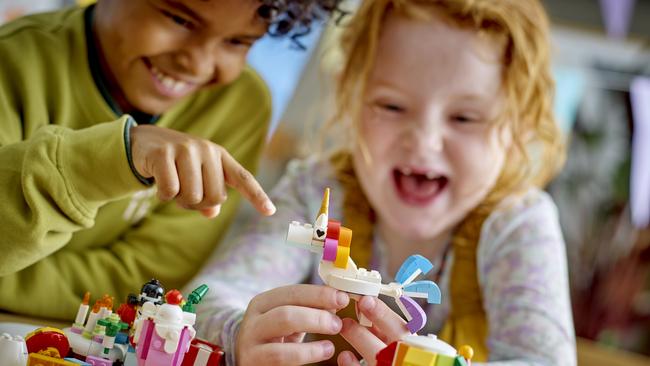Brick by brick: How Lego is building growth in a declining toy market
The universal appeal of Lego’s iconic brick is helping the brand compete against screen time and social media in the battle for kids’ and adults’ attention.

Lego is increasing its focus on digital platforms and new audiences including targeting young girls and adults as it seeks out pockets of growth in the declining toy market.
As the proliferation of digital screens, online gaming and social media lure kids away from toys and physical play, the 92-year-old Danish toy company has entered the world of digital gaming via a partnership with Epic Games.
Lego vice-president and general manager for Australia and New Zealand, Troy Taylor, told The Growth Agenda the launch of a Lego version of the smash hit world-building game Fortnite was the brand’s “if you can’t beat them, join them” moment.
“Kids are attracted more to screens these days and getting them away from screens is a challenge that all toy companies face, including Lego,” Mr Taylor said.
“Through Lego Fortnite, kids are building worlds, they’re using their imagination, they’re experimenting, and they’re collaborating through play in a safe environment.”
While physical play remains Lego’s paramount focus, the move reflects the need to respond to kids’ changing behaviours and provide a digital and physical building experience.
It also provides another avenue for growth via the new Lego Fortnite product range the brand is poised to launch.
“Physical play is at the heart of everything we do,” said Mr Taylor, who has been with the Danish toy company for 22 years, working in Australia, China, Singapore, Malaysia and the US.
“It’s all about the brick and any extensions of the brand have to complement the brick.”
The move into online gaming is a crucial play to help Lego maintain relevance with kids as they outgrow physical toys and embrace digital lives.
It’s also a strategic move to reach new audiences as the toy market continues to contract. Australia’s toy market endured one of its toughest years in over a decade in 2023, with a double-digit fall in sales.
Lego, however, bucked the downward trend, reporting growth in sales and market share.
The brand occupies a unique position in the local market where it boasts 95 per cent brand awareness and is the biggest toy brand both in size and market share.
Despite these strengths it is not immune to the power of the digital world and is banking on having a foot in each camp.
“There are a lot of children who have a passion for gaming, who may not have had a Lego experience or been interested in Lego before,” Mr Taylor said.
“We’re hoping that playing with a digital version of Lego may lead to (kids) buying a physical set. It’s a recruitment tool to hopefully recruit them into playing with physical Lego bricks through their passion for gaming.”
As Lego seeks out new audiences, it is also acknowledging audiences it has unknowing under-served in the past.
Speaking at the recent AANA RESET conference for marketing leaders in Sydney, Lego senior vice-president and head of the Lego Agency Nicole Taylor, said one of the top priorities are girls.
“From a growth perspective, this is an audience that we are under-serving,” Ms Taylor said. “Not deliberately, because the brick has no bias; it doesn’t have a gender. But because we use language like ‘building’ and construction toys were mostly associated with boys, we over-index on the boys.”
In a bid to correct the gender balance, the brand has invested in more girl-focused and unisex product ranges, such as the Dreamz and Friends sets, and has also tapped into new ranges created around passion points such as sports or flowers.
However, the challenge to engage young girls in play goes well beyond the Lego brick, according to Mr Taylor.
“The girls’ toy category is the toughest because of age compression. Girls mature much faster than boys and their play patterns differ – especially now with social media and online influences,” he said.
“Girls leave the toy category, on average three to four years earlier than boys. We have great success in keeping boys to at least 12, but girls are dropping out of the toy category from eight to nine years old, which is quite a challenge for a lot of toy companies.”
Lego has also identified other key audiences to accelerate growth. One of the company’s fastest-growing segments is the 18-plus adult range, packaged in distinct black boxes.
Mr Taylor said this segment had tripled since the pandemic and could be largely attributed to the halo effect of the Lego Masters TV show, which has just wrapped its sixth season on Channel 9.
Described as “the best advertising campaign ever made”, Lego Masters is credited with removing the taboos around adults playing with toys and also delivers a spike in sales throughout the season and in the following months.
Mr Taylor said Lego Masters, much like the Lego Movie before it, has contributed to the company’s popularity with people of all ages, which is reflected in its local performance, where the brand continues to “punch above our weight globally” and is one of the top ten markets for the Lego Group.
“I can’t comment on the numbers but we are already seeing healthy growth this year” Mr Taylor said. “Last year was challenging but we had growth in a declining market and this year we’re off to a better start. We’ve got a long way to go but the signs are really encouraging so far.”






